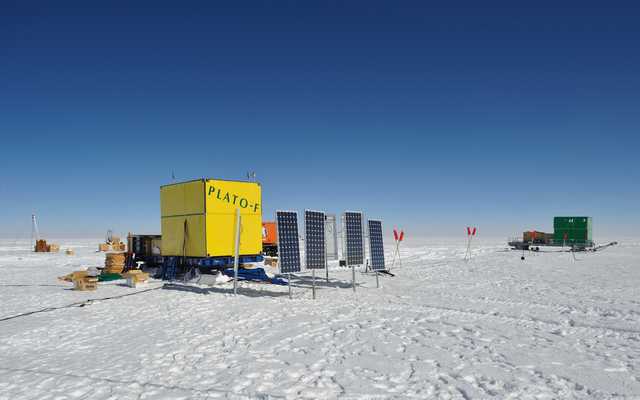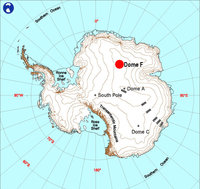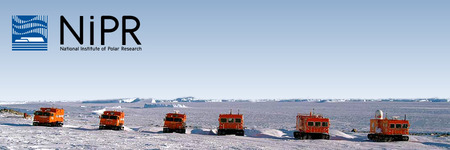Dome F, Antarctica
Over a decade of site testing in Antarctica has shown that the Antarctic plateau contains exceptional sites for astronomy, with certain atmospheric conditions (e.g., turbulence, water vapour content, and infrared emission) that are greatly superior to those at existing mid-latitude observatory sites.
Dome F, also known as Dome Fuji, is the second-highest summit of the Antarctic plateau, at an altitude of 3,810m. It is the location of the Japanese inland station.
The PLATO-F observatory
PLATO-F, the PLATeau Observatory for Dome F, is a self-contained automated platform for conducting year-round experiments completely robotically from the Antarctic plateau. It is the result of a scientific collaboration between universities in Japan and Australia.
PLATO-F runs without any human intervention on site. In fact, the closest person is over 1000km away and there is no possibility of any maintenance to PLATO-F until January 2013. PLATO-F has to generate its own electricity and heat, and is responsible for its own internet connectivity.
PLATO-F was taken to the Japanese inland station at Dome F by the 52nd JARE expedition in late 2010, by a 1000km traverse over a period of two weeks. PLATO-F is situated at a longitude of +39:41.66, a latitude of -77:19.27, and an elevation of 3802m (as measured with the GPS in the PLATO-F Iridium OpenPort satellite communications system). PLATO-F arrived at Dome Fuji in early January 2011, and began collecting scientific data on the 17th of January. The Mission Time at top right shows how long PLATO-F has been successfully running.
PLATO-F is an evolution of the original PLATO experiment that began operation at the Chinese Kunlun station at Dome A in January 2008. The original PLATO ran continuously for 204 days in 2008, and, following servicing missions in early 2009, and 2010, ran continuously throughout both these years. It is still running at the time of writing (March 2011).
 PLATO-F at Dome F, January 2011. The Instrument Module is yellow, the Engine Module is green. The four solar panels in the centre of the image face due north, to catch as much sun as possible. There are four other panels, in two pairs, facing south-east and south-west, to extend the period over which solar power is available. The Iridium communication aerials are on the roof of the Instrument Module (credit: Hirofumi Okita)
PLATO-F at Dome F, January 2011. The Instrument Module is yellow, the Engine Module is green. The four solar panels in the centre of the image face due north, to catch as much sun as possible. There are four other panels, in two pairs, facing south-east and south-west, to extend the period over which solar power is available. The Iridium communication aerials are on the roof of the Instrument Module (credit: Hirofumi Okita)
Power systems and control
PLATO-F consists of two fibreglass modules, each the size of a standard 10-foot shipping container and weighing 1.8 tonnes—light enough to be transported using a helicopter from the Japanese icebreaker Shirase. The Engine Module contains five Hatz 1B30 diesel engines and 6000 litres of Jet-A1 fuel. The Instrument Module is placed 50m away and contains the computer systems, battery bank, power supplies, and science instruments. Solar panels and the remaining instruments are external to both modules. The modules are extremely well thermally insulated.
The two modules are linked by a 120VDC cable that distributes up to 3kW of electrical power. A CAN (Controller Area Network) bus is used to control the modules. Solar panels provide an additional peak output of 1.3kW of electricity during the summer time, allowing operation almost entirely on solar power for several months of each year.
The PLATO-F computer system is based on two redundant PC/104 systems (Parvus ISIS/XL), each with an Iridium satellite modem for remote control and capable of transmitting up to 20MB of science data per day. An Iridium OpenPort system provides 128 kbps always-on internet connectivity. The computers boot from internal flash disks tested for low temperature and high altitude performance. A readonly filesystem is used for the Debian GNU/Linux "Squeeze" operating system to maximise reliability.
Instruments
PLATO-F is an international collaboration, with instruments contributed from Japan and Australia.
The height of the turbulent boundary layer between the ground and smooth air is of great interest to optical astronomers. The Earth's atmosphere makes the stars (and all other objects) twinkle in a similar way to a pebble seen through a rippling stream. If the boundary layer is very low, as it is predicted to be at Dome F, it becomes feasible to build telescopes on small (10–20m high) towers, greatly simplifying or even eliminating the adaptive optics needed to remove the effects of a turbulent atmosphere. Snodar is an acoustic radar that probes the atmospheric turbulence, mapping the height of the boundary layer and other atmospheric structure.
Please visit the science page for further information on the science that PLATO-F will be performing.
Participating institutions in alphabetical order
Funding agencies (in additional to the participants above) in alphabetical order
 |
|
 |
 |







